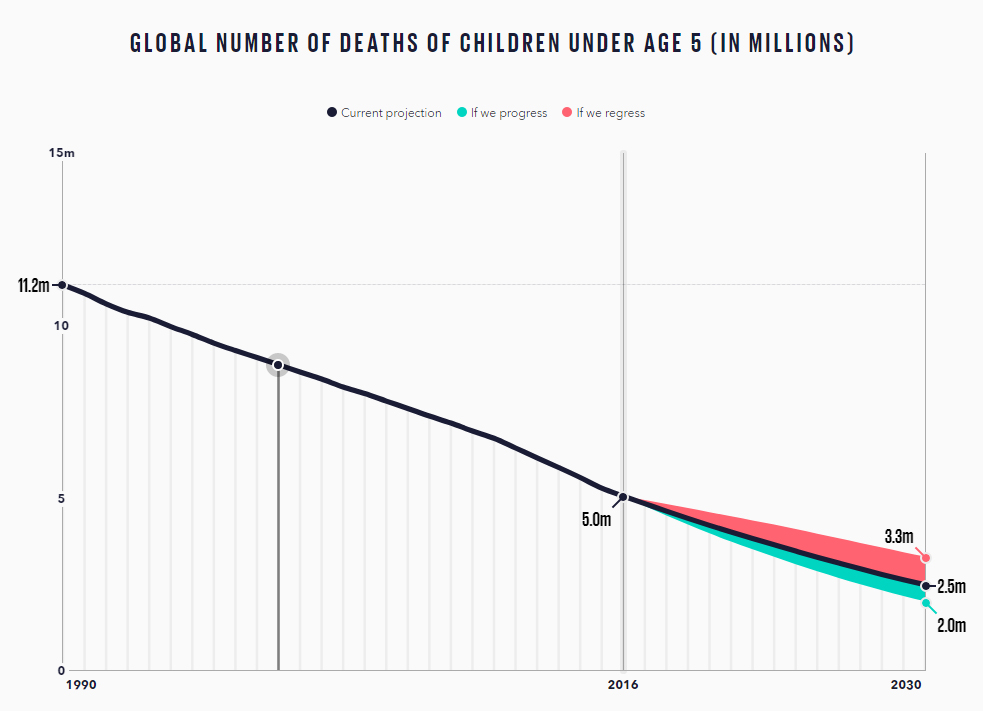
Justin Trudeau is heading to New York tomorrow for two days packed with events. Part of that trip includes a discussion with Melinda Gates at the Goalkeepers Conference, on the heels of the report of the same name. The Gates Foundation have been painstakingly collecting data from around the world focusing on different areas of health, and the results tell us a lot about how far we’ve come, and also how far we still have to go. The entire report is fascinating and I’ve been reading through and taking it all in.
The first point addressed in the report is child mortality, specifically children who die before the age of five. Obviously this one hits home, and the information about it brings both hope and questions.

As a planet we’ve come an exceptionally long way since 1990, and it’s amazing to reflect on the work of people like the Gateses and so many others who have done so much to bring vaccines and other medical care to regions of the world that didn’t previously have access. They are changing the world and saving lives on a massive scale, but they can’t do it alone. They need the ongoing support of the international community to push forward the progress they’re making towards their future goals in continuing to reduce the rate of child mortality.
‘There’s so much packed into that number. Child mortality is a proxy for overall well-being; it’s also a leading indicator of progress (or the lack of it). And when you talk to mothers who have experienced the death of a child, you understand what that number means in human terms. What is more fundamental than keeping children alive so they can thrive and build the future?’ – Melinda Gates
It’s hard to look at that number in 2016 without some sort of unidentifiable feeling about the fact that Jude was one of those five million. It’s easy to ‘other’ child mortality rates as something that isn’t a big problem in Canada. And it shouldn’t be. We have every resource available to us to protect our children. We don’t have to pay out of pocket for our vaccines or medical care. We have access to doctors, emergency services, and intervention when needed. But here we are with everything we need to protect the youngest part of our population, and we still have children dying from vaccine preventable diseases. We’re failing them and there’s shame in that.
‘About 1.5 million of the children who will die next year will die from diseases that we can prevent with vaccines. ‘ – Melinda Gates
The vast majority of us are not Gateses or Buffetts or heads of state. We don’t have the resources to change the world on a grand scale, and sometimes looking at the world as a whole it’s easy to feel overwhelmed by how big the problems are and how tiny our personal impact might be. But while we might not be able to do everything, we can still take actions that can help reduce the child mortality rate. That’s right – you can save children’s lives! Ready to be a superhero? Here are three ways.
1) Get a flu shot. Every year. You might think that the flu is nothing more than a bad cold or a stomach bug, but it’s actually a serious respiratory illness that claims ~3500 Canadian lives (and ~36,000 American lives) every single year. It almost always causes pneumonia. It can lead to sepsis. It can shut down your organs. And while these serious results are less common with perfectly healthy adults, they can happen to anyone, and our more vulnerable members of society (children under five, adults over 65, pregnant women, and people with underlying health conditions like cancer, asthma, and heart disease) need us to practice flu prevention to protect them. Jude was one in five million in 2016 after his body failed to develop immunity from his own shot, and there wasn’t enough flu prevention in our community to stop the spread before it reached him at the very end of the season.
Cost: FREE
2) Make sure you and your family are up to date on the rest of your vaccinations. Even if you were fully vaccinated as a child, you’ll need boosters as an adult. Check out the CDC’s schedule and talk to your doctor about making sure you’re caught up. Some people won’t develop immunity from their own vaccines, and others aren’t able to receive them at all. You aren’t just protecting yourself, you’re protecting those who are more vulnerable.
Cost: FREE
3) Purchase vaccines for developing nations through UNICEF. We’ve talked about this one before because we love it so much. The Super Hero Pack sends 100 vaccines, ten mosquito nets, and a vaccine carrier to regions that need them. You can save the lives of children you’ll never meet and make a dent in that five million number for kids who otherwise wouldn’t have access to those lifesaving vaccines. We think the Super Hero Pack has the perfect name, and we’ve just purchased another one in recognition of this report.
Cost: 80.78 USD
As we look ahead with the work we’re doing in flu prevention we hope that we’ll continue to see greater support from our elected representatives and leaders throughout all industries, and also from regular people like us. We can’t save the world, but we can take small steps and make differences in the lives around us. And those small steps can add up in big ways. We can’t save everyone, but maybe we can change the world for one person, and that’s everything.